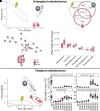Cynipid wasps systematically reprogram host metabolism and restructure cell walls in developing galls
- PMID: 38236304
- PMCID: PMC11181936
- DOI: 10.1093/plphys/kiae001
Cynipid wasps systematically reprogram host metabolism and restructure cell walls in developing galls
Abstract
Many insects have evolved the ability to manipulate plant growth to generate extraordinary structures called galls, in which insect larva can develop while being sheltered and feeding on the plant. In particular, cynipid (Hymenoptera: Cynipidae) wasps have evolved to form morphologically complex galls and generate an astonishing array of gall shapes, colors, and sizes. However, the biochemical basis underlying these remarkable cellular and developmental transformations remains poorly understood. A key determinant in plant cellular development is cell wall deposition that dictates the physical form and physiological function of newly developing cells, tissues, and organs. However, it is unclear to what degree cell walls are restructured to initiate and support the formation of new gall tissue. Here, we characterize the molecular alterations underlying gall development using a combination of metabolomic, histological, and biochemical techniques to elucidate how valley oak (Quercus lobata) leaf cells are reprogrammed to form galls. Strikingly, gall development involves an exceptionally coordinated spatial deposition of lignin and xylan to form de novo gall vasculature. Our results highlight how cynipid wasps can radically change the metabolite profile and restructure the cell wall to enable the formation of galls, providing insights into the mechanism of gall induction and the extent to which plants can be entirely reprogrammed to form unique structures and organs.
© The Author(s) 2024. Published by Oxford University Press on behalf of American Society of Plant Biologists.
Conflict of interest statement
Conflict of interest statement. None declared.
Figures




Similar articles
-
It's gall relative: metabolic profiling of two morphologically distinct oak leaf galls induced by cynipid wasps.Plant Physiol. 2024 Apr 30;195(1):248-250. doi: 10.1093/plphys/kiae032. Plant Physiol. 2024. PMID: 38252919 Free PMC article. No abstract available.
-
Genomic dissection of an extended phenotype: Oak galling by a cynipid gall wasp.PLoS Genet. 2019 Nov 4;15(11):e1008398. doi: 10.1371/journal.pgen.1008398. eCollection 2019 Nov. PLoS Genet. 2019. PMID: 31682601 Free PMC article.
-
Biochemical responses induced in galls of three Cynipidae species in oak trees.Bull Entomol Res. 2018 Aug;108(4):494-500. doi: 10.1017/S0007485317001055. Epub 2017 Oct 24. Bull Entomol Res. 2018. PMID: 29061198
-
The population biology of oak gall wasps (Hymenoptera: Cynipidae).Annu Rev Entomol. 2002;47:633-68. doi: 10.1146/annurev.ento.47.091201.145247. Annu Rev Entomol. 2002. PMID: 11729087 Review.
-
Recent Progress Regarding the Molecular Aspects of Insect Gall Formation.Int J Mol Sci. 2021 Aug 30;22(17):9424. doi: 10.3390/ijms22179424. Int J Mol Sci. 2021. PMID: 34502330 Free PMC article. Review.
Cited by
-
It's gall relative: metabolic profiling of two morphologically distinct oak leaf galls induced by cynipid wasps.Plant Physiol. 2024 Apr 30;195(1):248-250. doi: 10.1093/plphys/kiae032. Plant Physiol. 2024. PMID: 38252919 Free PMC article. No abstract available.
-
Exploring the diversity of galls on Artemisia indica induced by Rhopalomyia species through morphological and transcriptome analyses.Plant Direct. 2024 Jul 2;8(7):e619. doi: 10.1002/pld3.619. eCollection 2024 Jul. Plant Direct. 2024. PMID: 38962171 Free PMC article.
References
-
- Aloni R, Pradel K, Ullrich C. The three-dimensional structure of vascular tissues in Agrobacterium tumefaciens-induced crown galls and in the host stems of Ricinus communis L. Planta. 1995:196(3):597–605. 10.1007/bf00203661 - DOI

